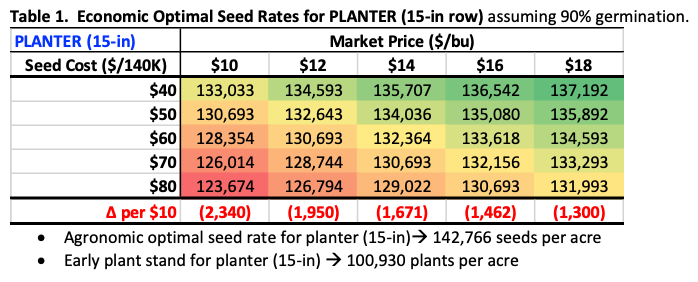Soybean seed rate selection is based on a number of factors such as germination score, seed quality, variety, seed protection, planting equipment, and field conditions. Germination score of 90% is fairly standard, though I have seen a few seed lots below that mark and even some that have been pulled and replaced this season. Please be sure to check your seed tags!
Varieties have different growth habits and many companies suggest various seed rates based on vigorous or rank growth habit, shorter heights, less branches, etc. Other seed rate changes can be recommended based on a variety’s disease protection or the lack thereof when a dense canopy of soybean plants can be prone to infection (e.g., white mold, Septoria brown spot, frogeye leaf spot). Another related factor depends on seed treatments used to protect soybean from seedling diseases like Pythium and/or Phytophthora. Seed rates can often be reduced with fungicide seed treatment is used that can protect young developing seedling rather than sacrificing seed and seedlings by planting more seeds. Insecticide seed treatment rarely provides return within Indiana, so a ~$10 to 15 seed treatment savings is possible.
The remaining factors of planting equipment and field conditions create sources of variation in seed rate recommendations. My standing AGRONOMIC recommendation has been to target 100 to 120 thousand PLANTS per acre regardless of row width, planting equipment, and field conditions. Target plant population will not change, but the seed rate will change primarily due to planting equipment. Higher seed rates with drills vs. planters. Seed rates should often be increased in tougher field conditions (e.g., cool and wet).
We have been conducting field-scale seed rate trials across Indiana since 2010 with drills and planters (a couple air-seeders in the mix) in no-till and tilled field conditions. Planting dates have ranged based on the growing season. We started evaluating two varieties in many of the fields since 2015 based on growth habit (“slender” vs. “bushy”), yield potential, and maturity (full vs. slightly shorter season). We have been able to use 58 of these trials from 2010 to 2021 to divide the data sets in multiple ways. Today, I will discuss the recommendations based on planting equipment and economics. Yes, economics.
Planting Equipment. The overall story has not changed. The drill still needs more seeds to attain the same plant stand compared to a 15-in planter. The agronomic optimal seed rate for the 15-in planter was just under 143,000 seeds/acre (90% germination); whereas, the drill (7.5-in and 15-in rows) was 173,000 seeds/acre (90% germination). Agronomic optimal plant stands were both ~100,000 plants/acre early in the season.
Economic Optimal Seed Rates. We really wanted to factor in seed costs and market price considering price range and volatility over the last 6 months. We used the agronomic yield response curves to create economic optimal seed rates (EOSR) based on a range of seed costs and market prices when using a planter vs. drill (Tables 1 and 2).
For instance, the EOSR for 15-in planter with seed costs of $60 per 140K unit and market price of $16 is 133,618 seed/acre. If your seed costs went up to $80 per 140K unit, then your EOSR decreases ~3000 seeds/acre to 130,693 seeds/acre (Table 1). Please note plant stands will be lower (obvious, but true). Our trials averaged ~70% establishment rate for planters, which includes the 90% germination score and emergence potential across the field conditions. Therefore, the last EOSR of 130,693 seeds/acre would have a stand near 91,500 plants/acre.
As a point of comparison and adjustment based on planting equipment, the EOSR for drill with seed costs of $60 per 140K unit and market price of $16 is 159,237 seed/acre. If your seed costs went up to $80 per 140K unit, then your EOSR would decrease~4600 seeds/acre to 154,636 seeds/acre (Table 2). Our trials averaged ~57% establishment rate for drills, which includes the 90% germination score and emergence potential across the field conditions. Therefore, the last EOSR of 154,636 seeds/acre would have a stand near 88,150 plants/acre.
All of the EOSR will be below the agronomic optimal seed rate since we are looking to optimize profits (i.e., balance of input costs, market price, and yield production). The EOSR will decrease as seed costs increase; whereas, the EOSR will increase as your market price increases.
Please use these tables to adjust your seed rates based on planting equipment, seed costs, and market price. You may need to increase your seed rates if your germination scores are below 90%, field conditions are cool and wet, heavy residue, or seed is not treated with fungicide.




